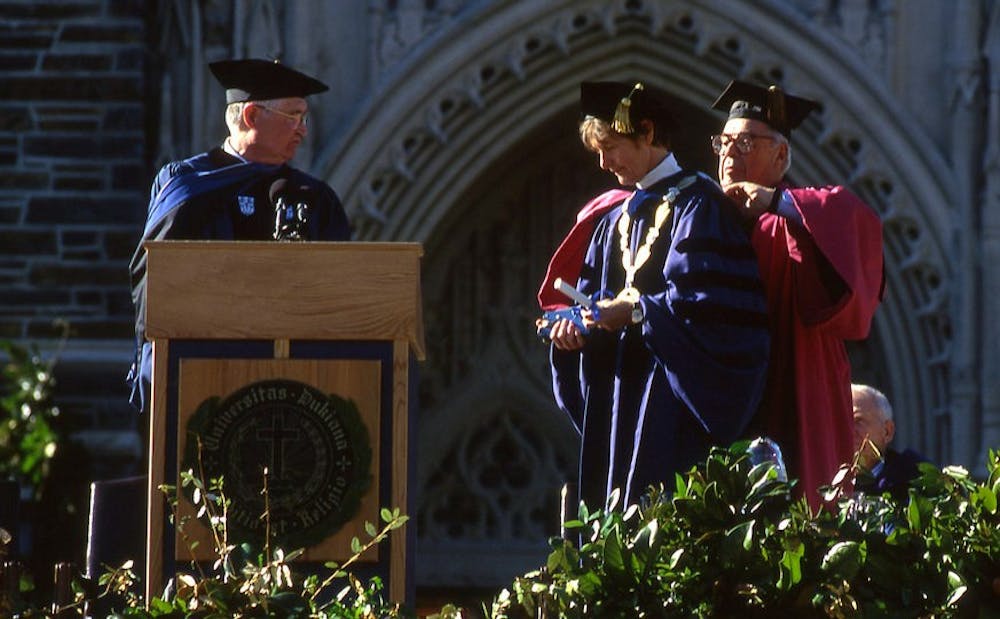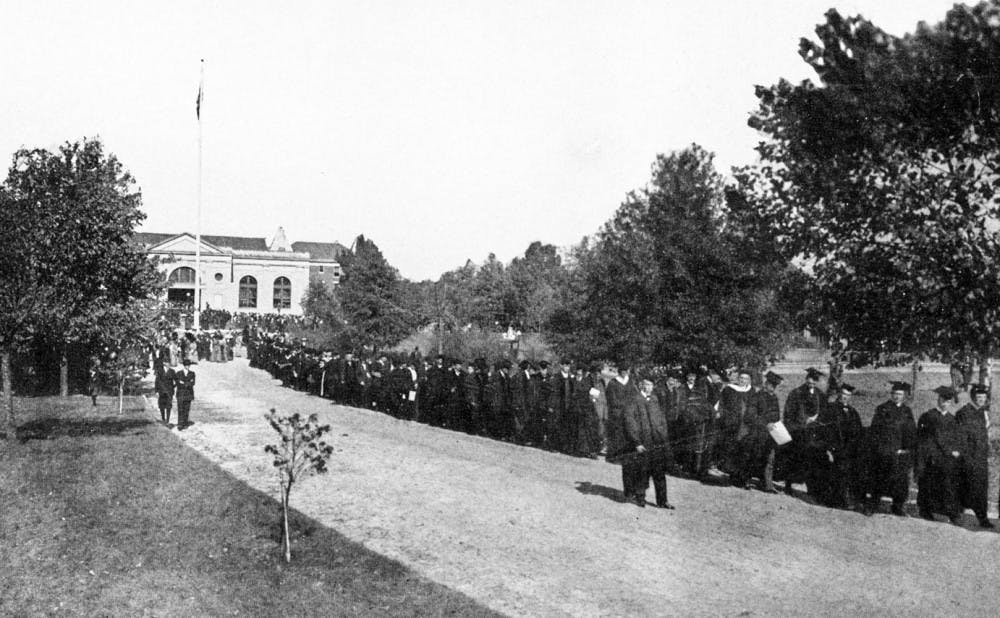Even though President Vincent Price began his presidential duties back in July, the inauguration on Oct. 5 officially marks Price’s commencement at Duke University.
“While there have been other moments President Price has interacted with the populations on campus, when you think of it, this is his first big reveal,” said Kaitlin Briggs, senior program coordinator of university ceremonies. “This will be the first time that he has an address that everybody can hear and really truly be a part of. This will be important to set the tone for the next 10 to 15 years.”
Yet, how will this year's commemorative carnival rides and free food compare to former presidents' inauguration festivities?
Earlier ceremonies
In 1949, Duke held its first presidential inauguration ceremony for President A. Hollis Edens—even though Edens was the University’s third president and ninth leader. Subsequent inauguration ceremonies have been modeled after this initial ceremony.
Before Edens, inaugurations were simpler affairs, like the start of John Crowell's presidency in 1887.
Crowell’s inauguration was not its own ceremony, but rather a set of exercises following that year’s commencement. In his personal recollections, Crowell wrote about how his inauguration took an unexpected turn when the class of eight students insisted he sign their diplomas even though he had not been inaugurated as president yet.
And sometimes, soon-to-be presidents consider backing down from the immense responsibility that comes with leading an institution.
On the eve of Crowell’s inauguration, nerves got the best of him as he considered refusing the presidency. He feared for the difficulty that would come with elevating Duke University—Trinity College at the time—beyond “a cheap, crude brick building, with not a single outbuilding, without even respectable sanitary facilities.” However, by morning, Crowell swallowed his doubts and decided to remain at the college, admiring its enduring force and spirit.
While Crowell's inauguration involved very little fuss, other inaugurations have been much more elaborate.
At President William Preston Few's inauguration in 1910 there were so many special delegates from other universities that a privately-chartered, luxurious Pullman train carried attendees to Durham from the primary East Coast rail line.
Yet, Duke’s presidential inaugurations have not always been such happy affairs.
At President Nannerl Keohane’s 1993 inauguration, students organized a silent protest, as part of the multicultural group Spectrum House's “We Want a Real Education” campaign. Holding signs and posters, campaign members criticized Duke’s curriculum as being too Eurocentric and not adequately broad or culturally inclusive.

Recent trends
Despite the simplicity in the earlier ceremonies, today presidential inaugurations are much grander and encompass more traditions, events and planning.
President Richard Brodhead's inauguration in 2004 was held inside the Duke Chapel—the first inauguration to be held indoors—due to remnants from Hurricane Ivan.
Terry Chambliss, senior director of special events and university ceremonies, described the standard ceremony as an academic procession including delegates from other universities and an installation part in which the president receives the symbols of office.
For inaugurations at Duke, the president always receives four objects: the charter of the university, the university seal, the chain worn at the university ceremony and the Duke bylaws.
Briggs recounted an amusing moment during Brodhead's inauguration involving the chain.
“There’s a moment when they were trying to put the chain on him, and it kept hitting his face. But the person putting the chain couldn’t see, so someone had to come help,” Briggs said, laughing.
In general, inaugurations take place several months after a university president takes office.
“Summer would just not be an ideal time because no one would be here. Students are gone. A lot of faculty are doing projects off campus,” Briggs said. “It also gives the president a little time to get the pulse of the university, so they can feel out what it’s going to look like for them as president as well as get their feet wet.”
Duke's presidential inaugurations, much like those at other universities, tend to have similar trends or overarching themes.
“In general, there’s some kind of way students are involved. [There’s] a general theme, but everyone tries to do something creative with it,” Briggs said.
Brodhead's ceremony capped off a week of inaugural festivities centered around the theme of Duke as a global institution, including talks on global health and global culture and the start of “Into the City,” a community service project focused on connecting Duke and Durham. Following his inauguration, there was a Saturday night soiree and Sunday morning Chapel service.
Inaugural week festivities
Planning for Price's inauguration took over a year, with the Office of Special Events and University Ceremonies in charge of checking space availability and organizing a steering committee consisting of Duke students, employees, alumni and trustees. The committee—as well as Price himself—made recommendations and gave input on the inauguration. The committee helped plan the traditional luncheon to welcome academic delegates, the faculty symposium and the community celebration in the Brodhead Center.
University Archivist Valerie Gillispie will organize a digital exhibit highlighting "important events and dates related to presidential history." She wrote in an email that the exhibit will be displayed on the library website and also posted outside the Gothic Reading Room in Rubenstein Library.
Both Briggs and Chambliss stressed the idea of inclusion and the importance of involving not only the faculty and students at Duke, but also the greater community.
“Our theme is to be inclusive of students and faculty and alumni, and I think in our history, the program has been the same, incorporating the wider Durham community,” Briggs said.
On October 4, the night before the inauguration, there will be the PricePalooza, which is sponsored by students and the Office of Student Affairs, Chambliss said. The PricePalooza will be a huge carnival on East Campus with games, rides and food.
Briggs explained that PricePalooza was a way to directly involve students in the inaugural activities. Registration for PricePalooza wristbands as well as inauguration information can be located on the inauguration website.
The inauguration itself will be live-streamed—another way for students to get involved, Chambliss noted.
This year’s inauguration includes a faculty symposium with two panels of Duke faculty. Price himself will commentate on the first panel and Provost Sally Kornbluth will serve as a commentator for the second. Briggs and Chambliss said that the symposium is a way to involve faculty.
Following the symposium, the inauguration ceremony will take place at 5 p.m. when faculty and delegates join the academic procession and Price gives his inaugural address.
The inauguration will also welcome President Amy Gutmann from Price's former institution—the University of Pennsylvania—to speak at the ceremony.
"We haven’t always had someone from outside come and speak this way, so this is a newer element," said Briggs.
The ceremony will be in the heart of West Campus on Abele Quad, a traditional inauguration location. In the event of rain, the ceremony will be moved into the Duke Chapel.
An array of performers, including the Duke Chorale, will be on hand for the night’s festivities. After the ceremony, a community celebration open to the public will take place in the Brodhead Center. Chambliss said this year’s inauguration will definitely have a lot of food, perhaps challenging the 20,000 hors d’oeuvres and 10,000 sweets at Keohane's inauguration.
As the sun goes down, the buildings will light up blue, against a backdrop of fireworks flying through the sky.
“President Price wanted it to be something that the community could be excited about and felt a part of,” Chambliss said.
Get The Chronicle straight to your inbox
Signup for our weekly newsletter. Cancel at any time.

